Enchanting, memorable, informative, and great fun! These are some of the words that come to mind when I remember our recent tour of historic homes and buildings of Camden, South Carolina. Members of the Charlotte Chapter of the Institute of Classical Architecture & Art hosted this tour on October 19-21.
A sister city to Charleston, Camden is rich in heritage and history. Founded in 1733, Camden is the oldest inland city in South Carolina. During the Southern Campaign of the Revolutionary War, Camden served as a repository for supplies of the British army. Young Andrew Jackson was among the many imprisoned in Camden’s Gaol (jail) during that time. More than a dozen skirmishes were fought in the environs and two major battles: The Battle of Camden and the Battle of Hobkirk’s Hill. Although won by the British, the battles were costly enough to force the Redcoats to evacuate. The abandonment of Camden was key to the Americans regaining control of the war in the South and a link to the chain of events that led to the surrender at Yorktown.
In the early 1900's, the town evolved into a resort town, housing the wealthy from all over the east coast through the winter months. Many of these wealthy, part-time residents brought their thoroughbred horses with them. Because of this heavy equine influence, Camden developed a rich history of polo, steeplechase, and other equine-related activities. They also breathed new life into Camden's fine old homes and gardens.
 |
| Members of the Charlotte Chapter of the ICAA and several guests visited historic Camden, SC on October 19 - 21, 2012. From left to right on stairs: Donna Goodwin, Don Duffy, Alina Bartlett, Sarah Pursley, Jeff Allen, Christian Patterson, Brian Speas, Allen Brooks, Nick Greene, Ted Stick, Tom Wigley, Laura Duffy, Richard Bartlett, and Ken Pursley. Lower level: Jeff Davis, Grace Mynatt, Charles McLarty, Frank Smith, Rosalie Reynolds, and Phil Goodwin. Not pictured: David Kelly. This photo was taken at Horse Branch Hall. |
.jpg) |
| Upon arrival in Camden, participants gathered at the Bethesda Presbyterian Church late in the day on October 19th. Built in 1822, the church is one of the few churches surviving that was designed by Architect Robert Mills. It was declared a National Historic Landmark in 1985. Becky Allen, wife of the late Master Builder Robert Allen, spoke on his work and his legacy as chronicled in the book, Tending Old Houses: The Renovation Artistry of Robert H. Allen. |
 |
| The following day, we visited the first home on our tour, the Washington House circa 1785. This impressive home was the site of an elaborate reception and banquet for President George Washington during his visit to Camden in 1791. The home was moved in the early twentieth century from the heart of downtown Camden to its present location. Dr. Tray Dunaway, current Owner of the home, described the arduous and slow (3 month) task of moving the home by rolling it on logs. |
 |
| Frogvale circa 1848 - the second home on our tour. The current Owners have lovingly restored this home with great attention to detail and with a sensitivity to the original design. The interior was beautifully appointed with furnishings and amazing artwork including an original by British-American artist J. G. Brown (1831 - 1913). James and Mary Boykin Chesnut, the Civil War diarist who authored A Diary from Dixie, lived in this home from1848 until 1856. |
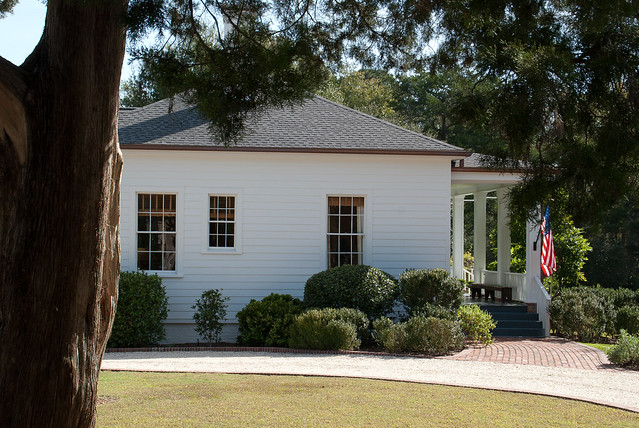 |
| Left elevation of Frogvale |
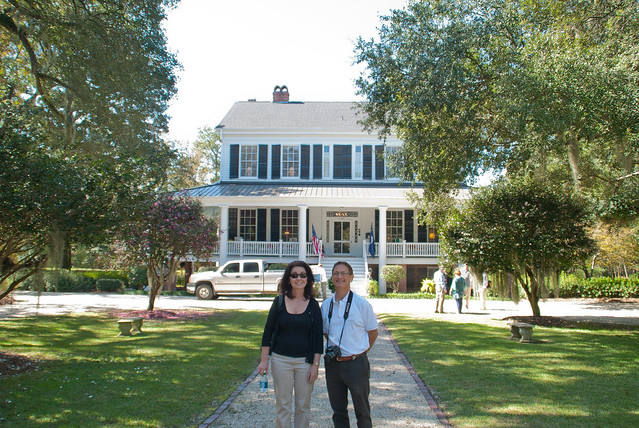 |
| Our next stop was Bloomsbury. Originally built in 1849 by James Chesnut, Sr. and Mary Cox Chesnut for their daughter, Sally, Bloomsbury was often host to Mary Boykin Chesnut. It is now a beautifully restored Bed and Breakfast. Donna Goodwin and Frank Smith shown here enjoying the sights, the company, and the perfect weather we had on our tour. |
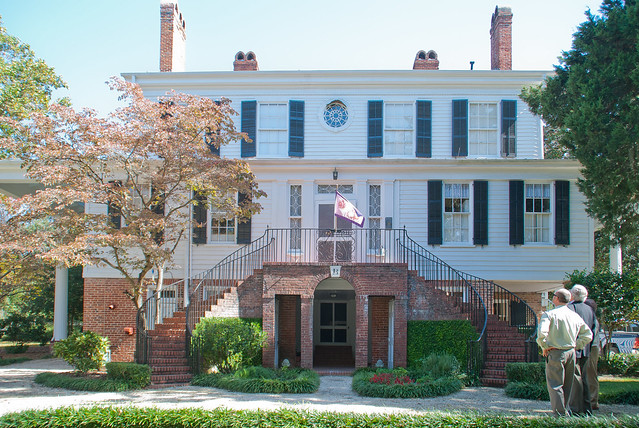 |
| The rear elevation of Bloomsbury with its elegant double staircase. |
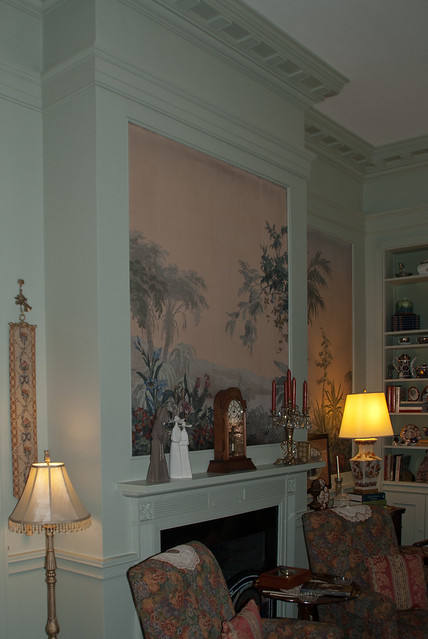 |
| The parlor inside Bloomsbury with wallpaper (or should I say papier peints) by (OMG!) Zuber. We estimated 15 feet for the height of the soaring ceilings. |
 |
| Another view of the parlor - and more Zuber |
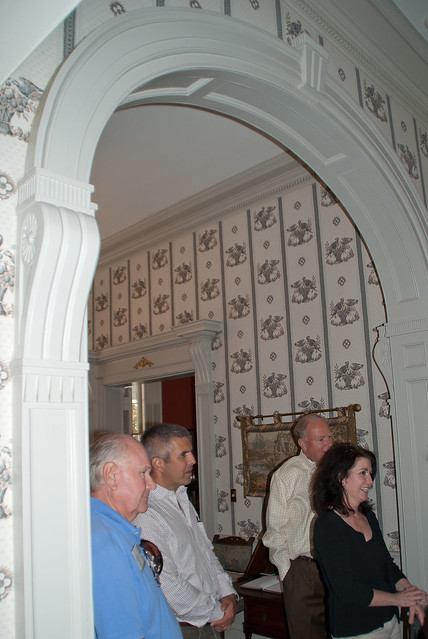 |
| The main hallway in Bloomsbury with its beautifully detailed arched opening. From left to right: David Kelly, Brian Speas, Tom Wigley, and Donna Goodwin. |
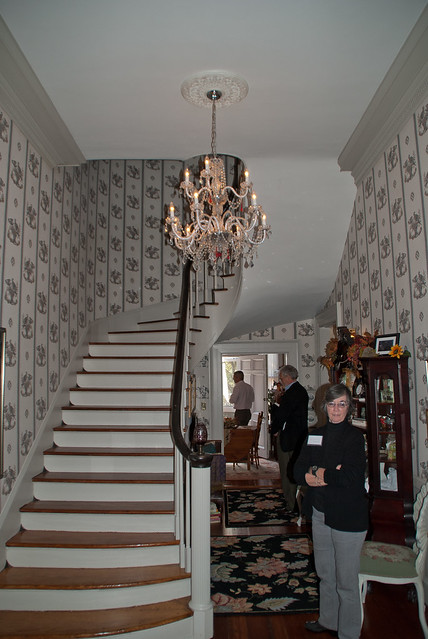 |
| The elegant staircase in Bloomsbury. Pictured is our guide extraordinaire, Joanna Craig. Joanna is the Director of Historic Camden and has a wealth of knowledge on the history of Camden. |
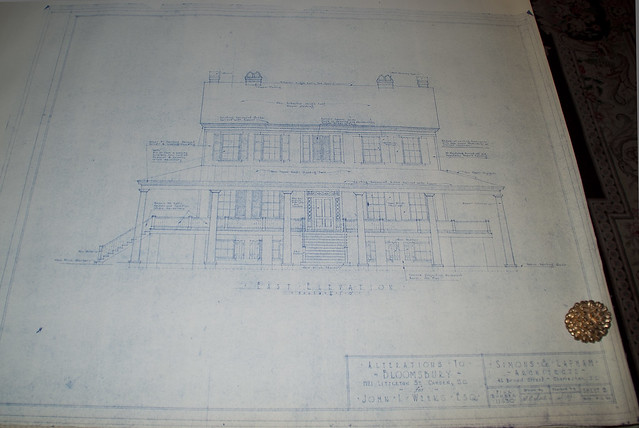 |
| On display at Bloomsbury were drawings for a 1930s renovation by the Charleston Architectural firm of Simons and Lapham. By clicking on the photo to enlarge it, you will see that the plans called for "A New Asbestos Roof" and the woodwork (probably finished with heavily leaded paint) to be "Burned off". How things have changed! |
The Bloomsbury Inn is currently owned by Bruce and Catherine Brown. After we enjoyed lunch on the terrace, our host spoke on the history of Bloomsbury and why so many antebellum homes were spared the destruction of Sherman's forces. He said that after burning Columbia, Sherman's troops set up a bivouac five minutes north of Camden. Targeting places of supplies and resistance, they only burned a home and a warehouse. Because it rained heavily while the troops were there, and because they were evidently in a hurry, the troops moved on. "Camden was just lucky", he said.
.jpg) |
Mulberry Plantation, circa 1820, was the fourth home on our tour. This was a special opportunity in that this landmark "does not go on tour". After their marriage in 1840, James and Mary Boykin Chesnut took up residence at the plantation where James was born and which belonged to his Father, James Chesnut, Sr. It was declared a National Historic Landmark in 2000. We were allowed to tour the entire home, but no photographs, please! A special thanks to Martha Daniels and her extended family who invited our group to visit their ancestral home.
|
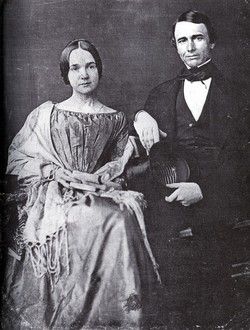 |
| James and Mary Boykin Chesnut as a young couple |
Mulberry plantation is where Mary Boykin Chesnut (1823 - 1886) resided when she wrote most of her diary. The following passage is one of her most vivid descriptions of Mulberry and her life there during the early years of the conflict:
My sleeping apartment is large and airy--has windows opening on the lawn east and south; in those deep window seats, idly looking out, I spend much time. A part of the yard which was a deer park once has the appearance of the primeval forest--the forest trees having been unmolested...are now of immense size.
In the spring the air is laden with opopanaz, violets, jasmine, crab apple blossoms, roses. Araby the blest never was sweeter perfume. And yet there hangs here as in every Southern landscape the saddest pall...
Please visit www.civilwarwomenblog.com/2010/07/mary-boykin-chesnut.html for an excellent review of the life of Mary Boykin Chesnut.
 |
| In the early evening, we met for cocktails on the grounds of Aberdeen, circa 1810. Rich in history, Aberdeen was once seized by Charles Cornwallis for use as British headquarters. Aberdeen is currently the gracious southern home of Mr. Jack Brantley, proprieter of Aberdeen Catery. Mr. Brantley loves to show his striking collection of antiques and porcelains, some inherited and some collected from all over the world. |
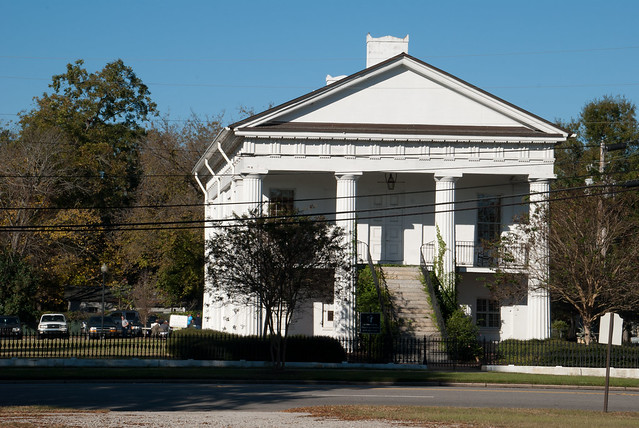 |
| Later that evening, we met at the old Kershaw County Courthouse, circa 1825, for an excellent banquet catered by none other than Aberdeen Catery. Needless to say, the meal was perfect. Dr. Tray Dunaway, Chairman of the Historic Camden Foundation, gave a presentation on the treasures of Camden. Dr. and Mrs. Dunaway were also very gracious by opening up their home to us - the Washington house and the first home on our tour (shown above). |
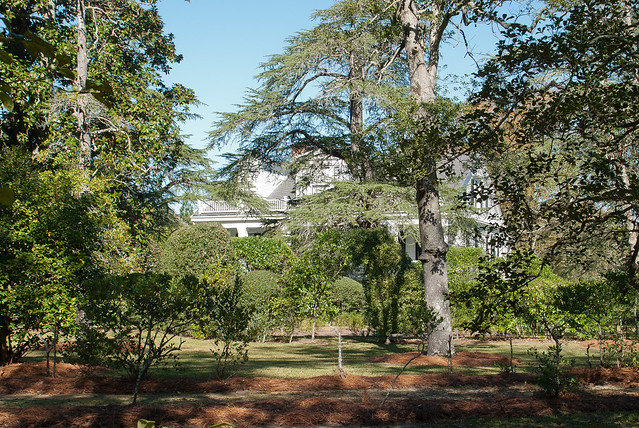 |
| On Sunday morning, we visited Holly Hedge, circa 1838. Noted philanthropist and horse enthusiast Marion Dupont Scott lived at Holly Hedge until illness confined her to Montpelier in Virginia. She bequeathed the Springdale Race Course to Camden. Springdale is the site of the Carolina Cup, and it is credited with giving Camden the reputation as the steeplechasing capital of America. Ancient trees and lovely undulating hedgerows concealed the view from the street. |
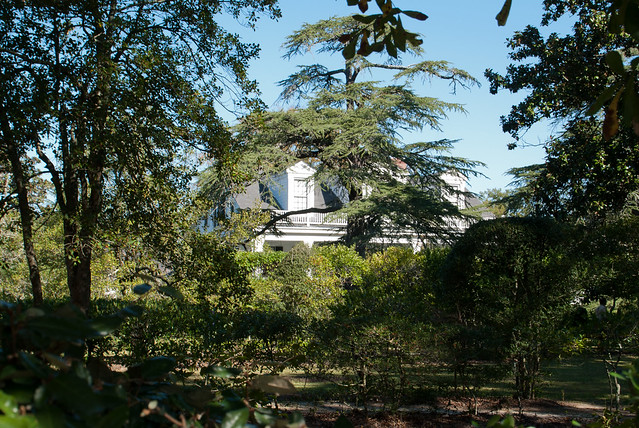 |
| Another view of Holly Hedge from the street. |
 |
| Horse Branch Hall , circa 1840 - the sixth home on our tour. According to the Owners, the lower level was originally unfinished, and horse-drawn carriages would enter directly under the terrace. |
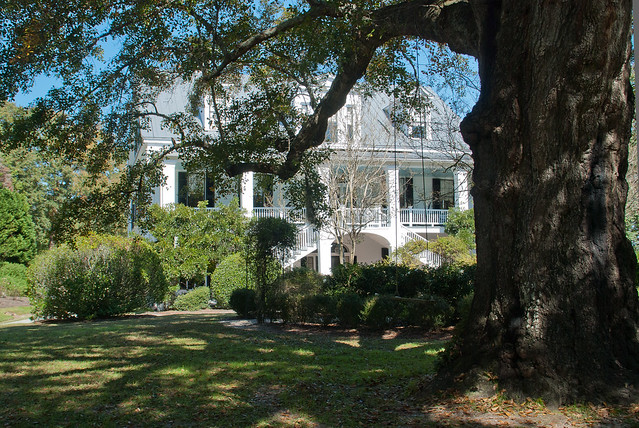 |
| A massive live oak graces the front yard of Horse Branch Hall. |
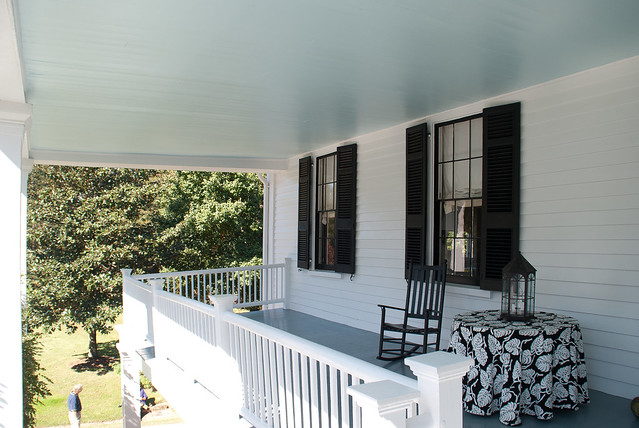 |
| The front porch at Horse Branch Hall. The "rain porch" or "Carolina porch" is protected from exposure to the elements by a roof which extends beyond the edge of the porch deck with independent supports that rise directly from ground level. It is believed that the rain porch originated along the coast of the Carolinas. |
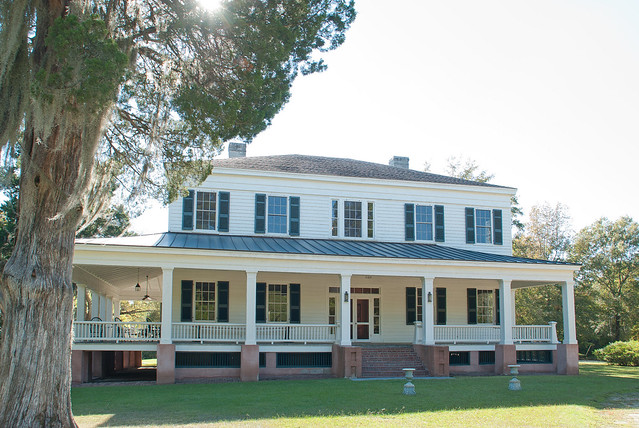 |
| Plane Hill Plantation, circa 1808 - the seventh and last home on our tour. In 1828, Mary Boykin and Steven Miller made Plane Hill Plantation their home. Their daughter, Mary Boykin Chesnut, grew up here. After a horrific 1923 fire at nearby Cleveland School, the home was donated for a school. The home eventually became a private residence again. The current Owners mentioned how several former pupils visited their old school and were moved to tears fondly remembering their experiences there. |
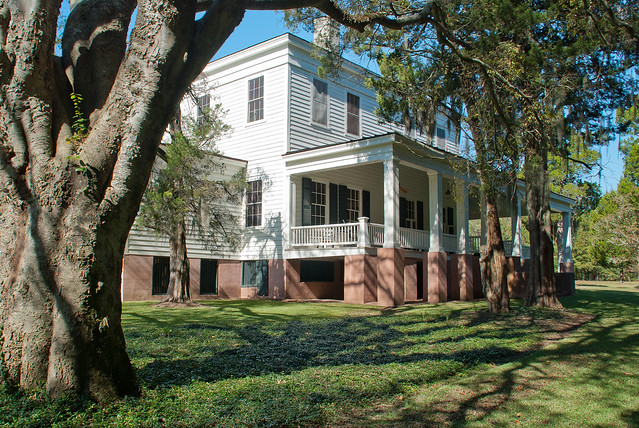 |
| Left elevation of Plane Hill Plantation. Another "Carolina" porch wraps around the left and front elevations. |
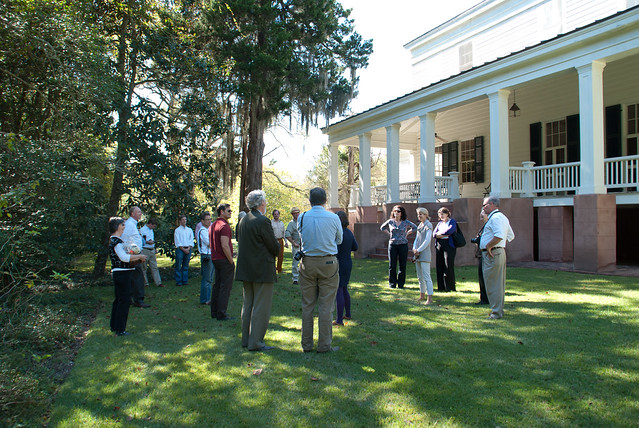 |
| The current Owners, the Brewers, discuss their restoration efforts and their labor of love |
 |
| I wonder how many hands of schoolchildren grasped this volute in days gone by? Over a foot in diameter and carved from one piece of wood that appears to be mahogany, it is artwork. |
I hope you enjoyed this review of our tour of historic Camden.
Special thanks to Lindsay Daniel, Don Duffy, Charles McLarty, Frank Smith, and Scott White for the considerable amount of time and effort they invested in planning and organizing this memorable event. Also, special thanks to chapter underwriter Ken Pursley of Pursley Dixon Architecture and tour sponsor Powell Fisher of J. L. Powell & Co. for their generous support.
For more information on The Institute of Classical Architecture &Art, please visit www.classicist.org and blog.classicist.org.















.jpg)




.jpg)





2 comments:
Thank You for sharing your knowledge, Really nice post
1 bedroom apartment in manchester
Thank you for sharing. Many of these are my ancestors' homes.
Post a Comment